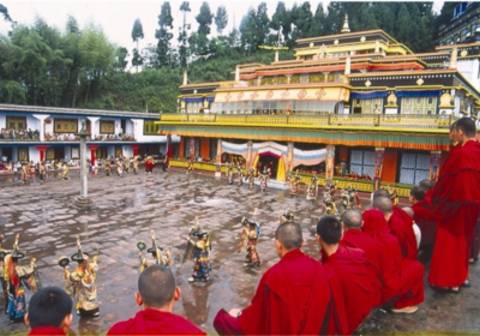Rumtek Dharma Chakra Centre, (Sikkim)

A 24 km drive from Gangtok through the beautiful countryside will take one to the Rumtek Dharma Chakra Centre. Located on the hill facing Gangtok, the Rumtek Monastry is the headquarters of the Kargyupa sect (Black Hat), one of the oldest Tibetan Buddhist sects and the seat of its head the Gyalwa Karmapa. This lavishly built monastery is said to be a replica of the Tsurphu Monastery of the Kargyupa order in Tibet and was built by the 16th Karmapa, an incarnate of the original Gyalwa Karmapa, the head of the Kargyupa sect of Buddhism.

The Kargyupa sect of Buddhism claims its origin in Tibet in the 12th century and it is held that after the first Karmappa spent several years meditating in the cave, 10,000 fairies came to congratulate him, each offering a strand of hair. A black hat woven from these strands of hair worn by the Karmappas on ceremonial occasions was passed down from generation to generation and is still at Rumtek Monastery. With its beautiful traditional architecture, carved and painted woodwork, magnificent murals,treasures, manuscripts and icons, Rumtek is a splendid example of the Tibetan monastic art in Sikkim. It is a flat roofed building with golden finials. The centre houses some of the world’s most unique religious scriptures, manuscripts and objects of religious art.
A fifteen minute walk downhill from Dharma Chakra Centre takes one to the old Rumtek monastery which was originally built in 1730 by the ninth Karmapa but was destroyed by fire and had to be reconstructed to the present state. His Holiness late Gyalwa Karmapa lived in this monastery till the completion of the Rumtek Dharma Chakra Centre. The monastery has now been completely renovated by a Sikkimese boy, who had mastered the trade of renovation from the Lamas. Embellished with monastic paintings in the traditional style, this monastery enshrines a stone slab marked with the footprint of Guru Padmanasambhava.
The annual dances also called the Tse-Chu Chaams are held on the 10th day of the 5th month of the Tibetan calendar around June. Dances called the Kagyat are also held here on the 28th & 29th day of the tenth month of the lunar calendar.


